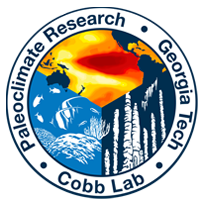Click here to meet the group!
Click here to read more about our research on Palmyra Atoll
Click here to read more about our research in caves
Read more about what our cores tell us here
Click here to read more about our research on Fanning Island
From left: Kim Cobb, Hussein Sayani, Jess Conroy, Liz Wiggins, and Diane Thompson.
Current Projects |
Our Research
Our group’s mission is to uncover the mechanisms of global climate change, both natural and anthropogenic, in order to inform projections of future climate change. We focus primarily on the generation of new high-resolution records of past tropical Pacific climate variability from corals and cave stalagmites, with an emphasis on the last decades to centuries. Through the thoughtful combination of climate models and data, we seek to characterize natural climate variability in this region and identify climate trends that are associated with anthropogenic climate change.
|










